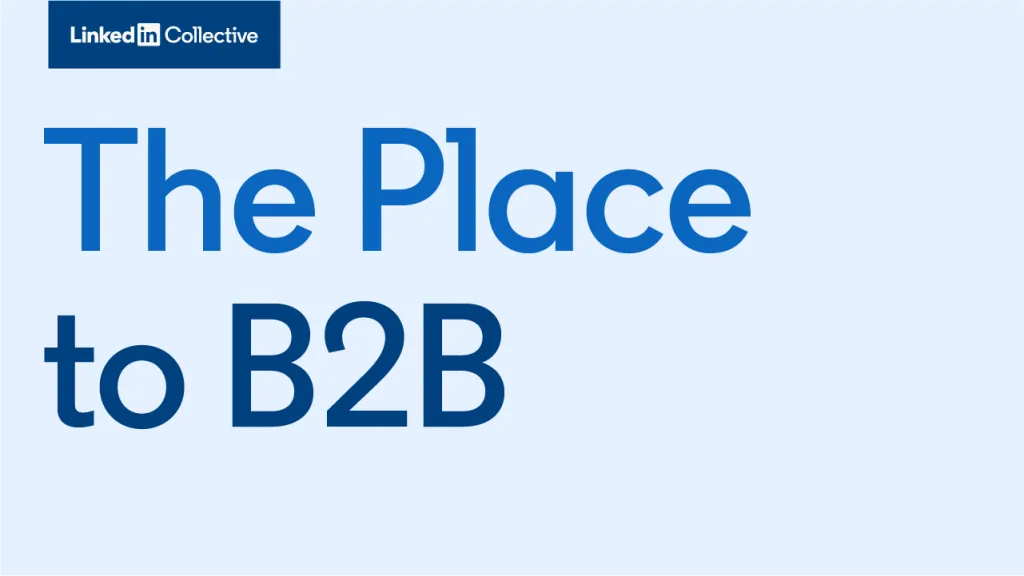LinkedIn has become an indispensable platform for B2B marketers looking to generate leads, build relationships, and drive sales. With over 850 million members worldwide, LinkedIn provides access to a massive professional audience.
However, simply having a presence on LinkedIn is no guarantee of success. Building an engaged B2B audience takes strategy, consistency, and an understanding of LinkedIn’s unique algorithms and features.
Table of Contents
Why Some Struggle With LinkedIn B2B Marketing

Even though LinkedIn presents a golden opportunity for B2B marketing, many companies still struggle to reap its full potential. Here are some of the common reasons why:
Targeting the right audience:
- Lack of clear buyer personas: Not understanding your ideal customer makes it difficult to tailor content and reach the right decision-makers.
- Overly broad targeting: Casting a wide net on LinkedIn wastes resources and leads to low engagement.
- Misusing targeting options: The platform offers powerful filters, but using them incorrectly can exclude relevant prospects.
Content and engagement:
- Inconsistent or low-quality content: Posting infrequently or sharing bland, generic content fails to attract or retain an audience.
- Missing the human touch: B2B audiences are still people, so overly promotional or jargon-filled posts don’t resonate.
- Neglecting engagement: Ignoring comments, messages, and discussions creates a one-sided, ineffective communication strategy.
Technical challenges:
- Mastering the platform: LinkedIn’s features and algorithms can be complex, leading to difficulties in optimizing campaigns and measuring success.
- Paid advertising woes: Navigating ad formats, targeting options, and budgets can be tricky, especially for those new to the platform.
- Lack of resources: Smaller companies or teams may not have the manpower or expertise to dedicate to consistent LinkedIn marketing.
Beyond the platform:
- Internal alignment: Siloed marketing and sales teams can hinder effective lead generation and nurturing.
- Unrealistic expectations: B2B marketing takes time and effort, and expecting overnight success can lead to disappointment and discouragement.
- Not tracking and analyzing results: Without measuring performance, it’s impossible to identify what’s working and what needs improvement.
These are just some of the reasons why some B2B companies struggle with LinkedIn marketing. By overcoming these challenges and focusing on creating valuable content, building genuine connections, and understanding their target audience, businesses can leverage the platform’s immense potential and achieve success in the B2B space.
Do you have any specific areas where you are struggling with LinkedIn B2B marketing? I might be able to offer some further insights or suggestions.
Also Read – What is the 411 Rule on LinkedIn?
LinkedIn B2B Marketing Best Practices

If you’re looking to improve your B2B marketing on LinkedIn, here are some best practices to keep in mind:
Define your goals and target audience:
- Know your “why”: What do you want to achieve through LinkedIn marketing? Brand awareness, lead generation, website traffic, or something else?
- Craft strong buyer personas: Understand your ideal customers’ needs, challenges, and decision-making processes.
- Refine your targeting: Use LinkedIn’s filters to reach the right decision-makers within your target audience.
Create valuable content and engage your audience:
- Focus on quality over quantity: Share insightful, informative, and relevant content that solves your audience’s problems.
- Mix up your content formats: Use articles, videos, infographics, polls, and even live streams to keep things interesting.
- Storytelling matters: Infuse your content with human elements and relatable stories to connect with your audience on a deeper level.
- Be consistently active: Post regularly and consistently to stay top-of-mind. Aim for at least 2-3 times per week.
- Spark conversations: Respond to comments and messages promptly, participate in relevant groups, and encourage discussions.
Leverage the platform’s features:
- Optimize your company page: Use high-quality visuals, a clear value proposition, and relevant keywords.
- Utilize LinkedIn Pulse: Publish longer-form content articles to showcase your expertise.
- Run targeted ads: Use LinkedIn Ads to reach specific audiences with tailored messages.
- Engage with leads: Leverage LinkedIn Sales Navigator to connect with potential clients and nurture relationships.
Go beyond the platform:
- Align your marketing and sales teams: Ensure seamless communication and handoff of LinkedIn-generated leads.
- Track and analyze your results: Use LinkedIn analytics to measure your performance and identify areas for improvement.
- Continuously learn and adapt: Stay updated on the latest LinkedIn trends and B2B marketing best practices.
Bonus tips:
- Personalize your approach: Adapt your content and engagement strategies to each individual or company.
- Show your brand personality: Don’t be afraid to let your unique voice shine through.
- Collaborate with industry influencers: Partner with relevant experts to reach a wider audience and build credibility.
- Offer free resources: Provide valuable tools, templates, or white papers to attract potential leads.
Remember, success on LinkedIn takes time and effort. Be patient, and consistent, and adapt your approach based on your results. By following these best practices and tailoring them to your specific needs, you can effectively utilize LinkedIn to achieve your B2B marketing goals.
I hope this helps! Let me know if you have any specific questions about B2B marketing on LinkedIn. I’m here to help you out.
Crafting Compelling LinkedIn Content

Quality content lies at the heart of any effective LinkedIn strategy. But in the crowded B2B space, producing content that breaks through takes insight and strategic planning.
Research Your Audience’s Pain Points
Too often, B2B brands put out content more focused on what they want to say versus what audiences need to hear. To create resonant, high-performing content, you must tap into the pain points and challenges your buyers face and then provide perspective.
Use surveys, conversations, support calls, and other methods to better understand what frustrates your LinkedIn audience. Then address these issues within your content.
This buyer-focused perspective provides value; positions your brand as an expert partner versus a product pusher; and gains audience engagement.
Curate a Diverse Content Menu
While many default to blog articles, visitors consume content in various formats. Include videos, infographics, slide presentations, checklists, polls, and more.
Catering to different preferences boosts engagement metrics that signal relevance to LinkedIn’s algorithm – more Likes, Comments, Saves, Shares.
Here’s a quick overview of type-specific best practices:
Blog Articles: Focus articles on SEO value with target keywords and intent-revealing titles. Keep intros scannable; incorporate subheads and bulleted lists.
Videos: Lead with a compelling title and thumbnail image. Start with a dynamic hook pulling viewers in. Integrate b-roll and graphics to add visual interest while avoiding static shots. Close with a clear CTA.
Infographics: Use large, readable text given LinkedIn’s feed display. Limit to key data for scannability. Employ icons and illustrations to convey concepts quickly.
Presentations: Break down concepts across multiple slides while avoiding immense detail per page. Use captivating slides with big text/bold graphics. Add presenter notes for context.
No matter which formats you leverage, the unifying best practice is crafting killer headlines. Given that followers scroll quickly, an intriguing title can spell the difference between ignored and viral posts.
Develop a Content Schedule
While the quality of individual posts matters, consistency and timing also impact performance. Sporadic posting fails to nurture follower relationships.
Construct an editorial calendar plotting out content by week or month based on company happenings, conferences/events, awareness days, seasonal topics, and evergreen themes.
This content mapping helps you post consistently while adding reminders for company milestones and tie-ins to current events.
In terms of timing, avoid posting during off hours or during Monday morning gaps when engagement lags. Mid-week mornings tend to see a nice uptake. Tailor to your audience’s habits.
Promote Content Off-Platform
Don’t silo LinkedIn content promotion solely to that network. Add social share buttons prominently on blog posts and landing pages. Market content across channels through emails, digital ads, external posts, and more.
Cross-promotion expands reach and gets content in front of those not routinely checking LinkedIn. Just ensure that content offers value before diverse external sharing to avoid quick exits or bounces.
Measure Performance
Gauge engagement levels – Likes, Comments, Shares, Saves. Review click-throughs to the site. Assess downstream lead form completions or sales from gated content offers.
These metrics reveal what resonates so you can refine topics and content types. They show formats providing value versus quick-exit posts that need retooling.
With performance tracking, you evolve efforts toward high-converting presentations, blog themes, and more. Now let’s explore how to target content for relevance and results…
Also Read – LinkedIn Pulse Comprehensive Guide
Precision Targeting For LinkedIn Content

Beyond quality and consistency, distributing content to well-defined audiences drives engagement and conversions. Yet many neglect audience segmentation when sharing posts.
By leveraging native targeting options within LinkedIn’s platform and tools, you can get content in front of key segments known to share interests, problems, and needs addressed by your solutions.
Here are 5 core targeting tactics to employ:
1. Target by Group
LinkedIn groups convene professionals by specialty from HR to Healthcare IT and Financial Advisors. There are over 2 million groups available.
Seek out and join groups aligned to your solution area and buyer personas. Pay attention to the most active ones sharing insights and discussing issues daily.
When posting, select groups matching the content’s relevance to ensure you reach engaged audiences open to messaging.
2. Leverage Audience Demographics
Within LinkedIn’s audience selection tools for content distribution and ads, filter by attributes like:
- Job Title/Function – CMO, Sales Director, IT Manager
- Industry – Healthcare, Finance, Manufacturing
- Company – Size, Location, Tech Stack
- Interests – Digital Transformation, Cybersecurity, Sustainability
Layer these filters to align content to roles, organizations, and passions associated with your offerings for relevance.
3. Create Targeted Audience Lists
Within Campaign Manager, build curated audiences based on filters like industry, job function, company size, and more. For example, compile IT Directors at Mid-Market Manufacturers.
Audience creation takes manual research and list development work upfront. But you can reuse tailored segments for multiple initiatives.
4. Implement Follower Lookalike Targeting
Have an existing group of highly engaged followers? Use Lookalike Targeting to find similar members to expand reach. This uses existing followers as a model for profiling new prospects.
5. Develop Buyer Personas
Conduct research through surveys, interviews, and support calls. Uncover shared pains, behaviors, and preferences among key customer profiles.
The document detailed personas and their attributes to inform content topics and segmentation filters






